|
|
|
Sort Order |
|
|
|
Items / Page
|
|
|
|
|
|
|
| Srl | Item |
| 1 |
ID:
100947
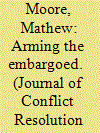

|
|
|
|
|
| Publication |
2010.
|
| Summary/Abstract |
Nearly every international arms embargo has been systemically violated by arms exporting states. Although much work has been done exploring why states transfer arms, little has been done to answer the question of why states choose to violate arms embargoes. Earlier studies have found that states transfer arms to one another for a variety of economic and strategic reasons. This study constructs a time series cross-section data set to test whether the same interests that drive dyadic arms transfers also influence the likelihood and size of arms embargo violations. Using a two-stage model of dyadic arms transfers, this study finds that measures for arms import dependence and alliance portfolio similarity best predict the likelihood and size of arms embargo violations. These results provide evidence that state decisions to violate embargoes are driven by political interests more than economic interests.
|
|
|
|
|
|
|
|
|
|
|
|
|
|
|
|
| 2 |
ID:
070157
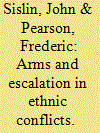

|
|
|
| 3 |
ID:
061286
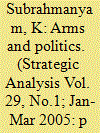

|
|
|
|
|
| Publication |
Jan-Mar 2005.
|
|
|
|
|
|
|
|
|
|
|
|
|
|
|
|
| 4 |
ID:
137846
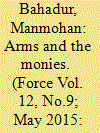

|
|
|
|
|
| Summary/Abstract |
When the history of Indian defence industry is written, there would be two sure contenders gunning for the title of the most controversial acquisition, viz., the 1984 purchase of the Bofors 155 mm artillery gun and the ongoing, mired in debate, Indian Air Force’s (IAF’s) Medium Multi Role Combat Aircraft (MMRCA) project. The former has outlived its utility as a missile in the political arena while the latter has just begun its journey as a potential one, post the decision of the government to acquire 36 Rafale fighters from France in a government to government (G2G) contract.
|
|
|
|
|
|
|
|
|
|
|
|
|
|
|
|
| 5 |
ID:
003912
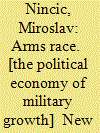

|
|
|
|
|
| Publication |
New York, Praeger, 1982.
|
| Description |
x, 209p.
|
| Standard Number |
0030603323
|
|
|
|
|
|
|
|
|
|
|
|
Copies: C:1/I:0,R:0,Q:0
Circulation
| Accession# | Call# | Current Location | Status | Policy | Location |
| 022365 | 355.82/NIN 022365 | Main | On Shelf | General | |
|
|
|
|
| 6 |
ID:
087994
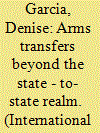

|
|
|
|
|
| Publication |
2009.
|
| Summary/Abstract |
Arms transfers beyond the state-to-state realm can have harmful effects for international security dramatically affecting the relations and behavior of states. This article examines why an emerging international norm on "prohibiting states to transfer arms to nonstate groups" has failed to diffuse at the international level. It discusses the already available international law framework existing at the regional and international levels upon which the potential norm could be built. The failure of the norm to diffuse at the international level can be primarily explained by the existence of a long-consolidated norm: the customary practice of states to transfer weapons to nonstate actors, that is, groups they deem legitimate to, without any interference or constraint.1 The unrestrained transfer of weapons is an established foreign-policy practice. It is the way states form, uphold alliances, extend friendships, and build spheres of influence (Sorokin 1994). Clearly, no state willingly wants to give this up. Therefore, the multilateral agreement on a norm barring most or all transfers of weapons to nonstate actors would curtail the freedom of action to build spheres of influence as states please. There are genuine ethical and moral dilemmas in this discussion, a nonstate actor may be a freedom fighter or a terrorist depending on different perspectives. The distinction between the categories "state" and "nonstate" actors may risk classifying actors in two camps: the good and the bad, respectively. This is problematic as a few states are known to be the most brutal perpetrators of egregious violations against their own citizens, whereas certain nonstate actors are legitimately fighting for the protection of vulnerable populations.
|
|
|
|
|
|
|
|
|
|
|
|
|
|
|
|
| 7 |
ID:
004042
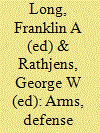

|
|
|
|
|
| Publication |
New York, W. W. Norton, 1976.
|
| Description |
x, 222p.
|
| Standard Number |
0393091880
|
|
|
|
|
|
|
|
|
|
|
|
Copies: C:1/I:0,R:0,Q:0
Circulation
| Accession# | Call# | Current Location | Status | Policy | Location |
| 022050 | 327.174/LON 022050 | Main | On Shelf | General | |
|
|
|
|
| 8 |
ID:
165752
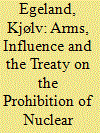

|
|
|
|
|
| Summary/Abstract |
The TPNW challenges the legitimacy of nuclear deterrence, but it would not eliminate deterrence in practice.
|
|
|
|
|
|
|
|
|
|
|
|
|
|
|
|
| 9 |
ID:
117525
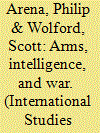

|
|
|
|
|
| Publication |
2012.
|
| Summary/Abstract |
How do states respond to uncertainty over their opponents' military strength? We analyze a model of crisis bargaining in which, prior to negotiation, an uninformed state chooses how to allocate scarce resources across armaments and intelligence gathering. Arming improves military capabilities, while intelligence gathering improves estimates of the other state's military capabilities. Our model thus allows both the distribution of power and the level of uncertainty in the crisis to be determined endogenously. We derive some notable results. First, the relationship between information revelation and war is conditional on beliefs held before the information is received, as more accurate information can reduce the probability of war for optimistic states but increase it for pessimistic ones. Second, the allocations that minimize the probability of war are often not those made in equilibrium. Finally, considering the interdependence between the two allocations yields unique insights into the relationship between the distribution of capabilities, uncertainty, and the risk of war.
|
|
|
|
|
|
|
|
|
|
|
|
|
|
|
|
| 10 |
ID:
123611
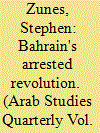

|
|
|
| 11 |
ID:
103432
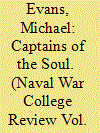

|
|
|
| 12 |
ID:
147798
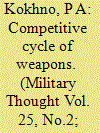

|
|
|
|
|
| Summary/Abstract |
The author studies the arms life cycle within his theory of the competitive cycle, i.e. its economic efficiency from production of items according to their intended purpose and further utilization. The author proves the necessity of application of methods to assess the full cost of arms supplied to the troops.
|
|
|
|
|
|
|
|
|
|
|
|
|
|
|
|
| 13 |
ID:
093121


|
|
|
| 14 |
ID:
105003
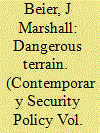

|
|
|
|
|
| Publication |
2011.
|
| Summary/Abstract |
The bases of legitimacy in recourse to war have, in recent years, come to turn vitally on meaningful discrimination between combatants and noncombatants. Concurrently, the remarkable successes of the movement to ban antipersonnel landmines and the follow-on ban on cluster munitions have likewise been predicated on this same arbiter of legitimacy, marking specific kinds of weapons as bad for their inherent indiscriminacy. This article begins by exploring sources of popular expectations that make official claims to discriminacy seem plausible. In particular, the role of popular representation is considered for its foregrounding of the technological feats of precision-guided munitions in ways that mystify ethico-political questions about their use. It is argued that this, more than any objective properties of weapons themselves, has been the truly revolutionary aspect of the so-called Revolution in Military Affairs (RMA). The implications of/in this for/by disarmament advocacy of the sort exemplified in the civil society campaign to ban landmines are weighed.
|
|
|
|
|
|
|
|
|
|
|
|
|
|
|
|
| 15 |
ID:
006609
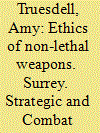

|
|
|
|
|
| Publication |
Surrey, Strategic and Combat Studies Institute, 1996.
|
| Description |
32p.
|
| Series |
SCSI;24
|
| Standard Number |
1874346143
|
|
|
|
|
|
|
|
|
|
|
|
Copies: C:1/I:0,R:0,Q:0
Circulation
| Accession# | Call# | Current Location | Status | Policy | Location |
| 038353 | 355.82/TRU 038353 | Main | On Shelf | General | |
|
|
|
|
| 16 |
ID:
185600
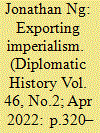

|
|
|
|
|
| Summary/Abstract |
On November 15, 1977, several thousand Iranians congregated in Lafayette Park. The shah of Iran’s trip to Washington, D.C. prompted a “blitz of competing parades, speeches, picketing, street theater, leafleting and general political huckstering.”1 The Los Angeles Times called it the “most turbulent day” at the White House since the antiwar demonstrations of the 1960s.2 Mounted police surveilled the opposing crowds. Regime supporters traded taunts with students wearing masks to protect their identity from secret police. During the monarch’s 1973 visit, protesters chanted, “Nixon, Don’t Arm the Shah!”3 Now Iran was the largest foreign consumer of U.S. arms. Reflecting the change in times, students carried new placards: “Stop Arming the Shah’s Regime.”4
|
|
|
|
|
|
|
|
|
|
|
|
|
|
|
|
| 17 |
ID:
131050
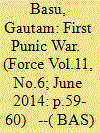

|
|
|
|
|
| Publication |
2014.
|
| Summary/Abstract |
The two leading Mediterranean powers in the post-Greek world clashed in three Punic Wars in the first of which Rome, now master of all Italy, overran Sicily, reinvented itself as a naval power and took its armies beyond Europe for the first time to Carthage in Africa
By the mid-3rd century BC, Romans had secured the whole of the Italian peninsula defeating in about 100 years every rival on mainland Italy. First the Latin League dissolved in the Latin War, then the Samnites were subjugated in three Samnite wars, and finally the cities of Magna Grecia submitted to Rome after Pyrrhus of Epirus withdrew (see FORCE May 2014). Barely decades after the last Pyrrhic War, Rome fought outside Italy for the first time. The First Punic War (264-241 BC) was the first of three fought between Carthage and the Roman Republic for supremacy in the western Mediterranean Sea. It was localised on the island of Sicily but Roman legions also landed on African soil. Carthage, located in today's Libya and Tunisia, was the world's leading naval power at that time. These wars were called 'Punic' from the Latin name for Carthaginians - 'Punici' derived from 'Phoenici' - who traced their origins to the Semitic-speaking peoples of North Africa descending from Phoenician traders of modern Lebanon and who spoke the Punic language. The Second Punic War (218-201 BC) is most remembered in military history for Hannibal's great crossing of the Alps with elephants to do what no man did before: attack Rome overland from the north. The Third Punic War (149-146 BC) involved an extended siege of Carthage, culminating in its conquest by Rome, ending the tale of one of the most illustrious military rivalries in history.
|
|
|
|
|
|
|
|
|
|
|
|
|
|
|
|
| 18 |
ID:
072463


|
|
|
| 19 |
ID:
005766
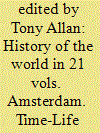

|
|
|
|
|
| Publication |
Amsterdam, Time-Life Books, 1989.
|
| Description |
176p.
|
| Standard Number |
0-7084-0979-1
|
|
|
|
|
|
|
|
|
|
|
|
Copies: C:1/I:0,R:0,Q:0
Circulation
| Accession# | Call# | Current Location | Status | Policy | Location |
| 037034 | R 930/ALL 037034 | Main | On Shelf | General | |
|
|
|
|
| 20 |
ID:
097187
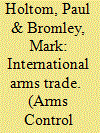

|
|
|
|
|
|
|
|